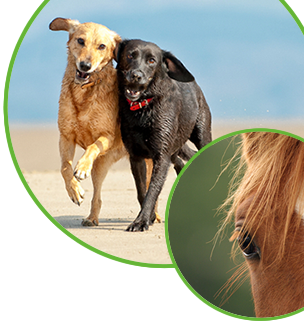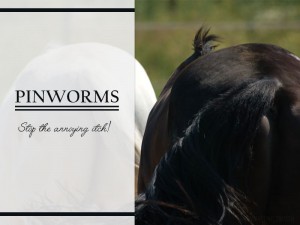
Pinworms, Stop the annoying itch!

Pinworms (Oxyuris equi) are roundworms that live in a horse's large intestine. Although these parasites don't have much impact in a horse's health, they can be very irritating causing itchiness around its tail and anal region.
The adult worms have a white-grey colour and the males are quite smaller than the females. The male worms usually exist in low numbers and are less than 1 cm long. The females however, can grow up to about 15 cm in length.
In order to lay their eggs females will migrate from the large intestine to the horse's anus where they partially emerge from the sphincter to lay their sticky eggs on the skin around the anus (outside the horse's body). The eggs are deposited in an easily recognisable yellow, white or green sticky fluid. These will hatch and become infective in three to five days. Then they will drop and end up contaminating the horse's environment, being able to survive for several months unhatched.
Horses become infected when they ingest the eggs found on pasture (from faeces), contaminated drinking water, feed or surrounding environment. Once they are ingested by the horse, the eggs hatch releasing larvae into the small intestines. They will then migrate to the large intestine and develop into an adult pinworm. Their entire lifecycle takes about 4 to 5 months.
Affected horses are often itchy, trying to rub their tail, bite and lick their hind quarters, which leads to the appearance of bald patches in these areas.
Although pinworm eggs will not appear in routine faecal worm egg counts, the diagnosis can be made either visually when the sticky fluid is deposited or your vet can perform an adhesive test. The eggs will be visible if a transparent piece of adhesive tape is applied over the anus and then examined under the microscope.
To keep these parasites away from your horse please make sure you keep up with your routine worming plan. Avoid using grooming equipment on more than one horse to keep the parasite from spreading from one horse to another.
If you notice your horse is more itchy than usual in its rear end or if you are able to identify the parasite, clean your horse's perineal area every three days to remove any eggs that may have been laid there. The best way to clean the horse perianal region is to use disposable materials, such as Baby wipes, which can then be carefully disposed of. This will not only prevent the worms from contaminating the environment and stop them from continuing their normal development but this will also relieve the horse from the itchiness and irritation.
Would you like to know more about horses? Check our Equine Courses:
![]()
Equine courses
Read the previous article: I just found a lost cat! - Now what?

